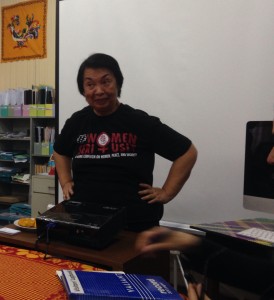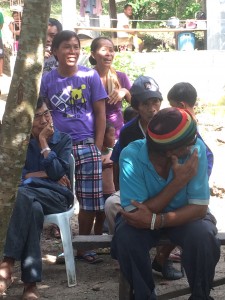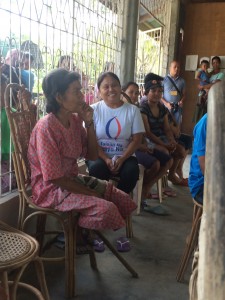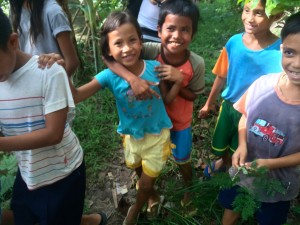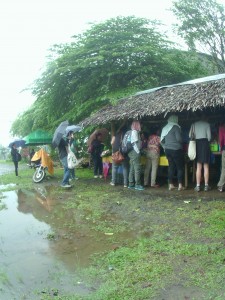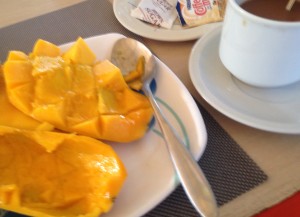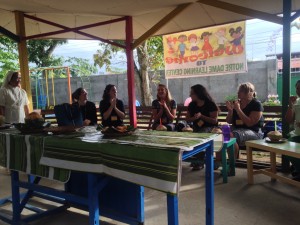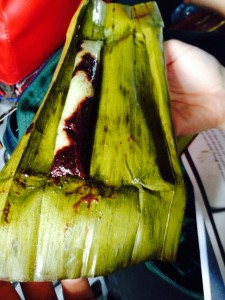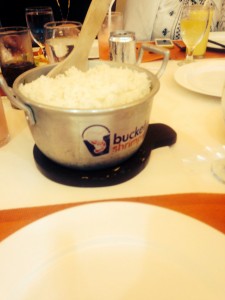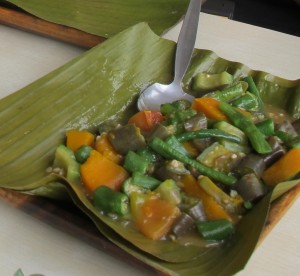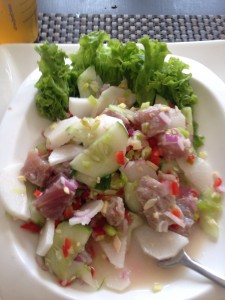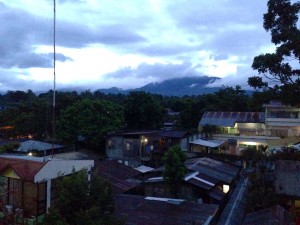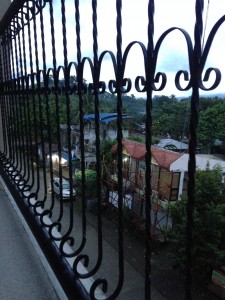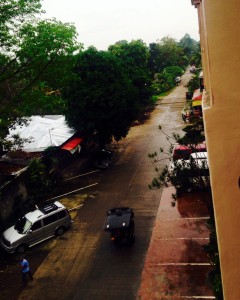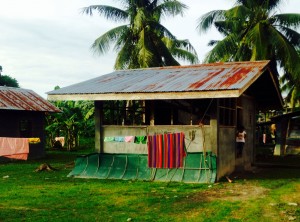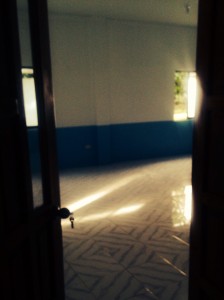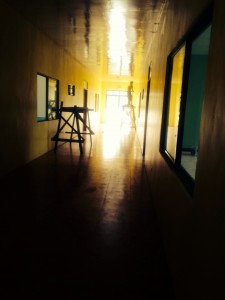Every time I reflect back on Mindanao, a different experience pops into my head. From three weeks we have a lifetime of memories and a foundation to keep learning from. Catholic Relief Services(CRS) were incredible hosts who have inspired many in their efforts to Peacebuilding, they are working hard and truly believe in the process. Looking back on our final meeting with CRS, Orsen stated the importance of being “ambassadors of the stories we heard.” I think that answers the question of where to go from here. I plan to be a continuous student, although we spoke to many about the peace process and conflict in Mindanao, there is still so much to follow up with.
Category Archives: Emma
Women=Peace
In preparation for the final presentation and being able to constantly reflect back to Mindanao through my courses that I am currently in, I have been able to see how the conflict has affected women and the roles that they have today. They have carried a strong conviction throughout all the challenges they have faced to bring peace to Mindanao. Women and youth, considered to be the victims of war, are the key advocates for change. The challenges women are faced with in times of conflict are many. Women who lose their husbands somehow have to care for their children while making a living. Often they are internally displaced, in constant instability, and live without the mobility that would allow them to recover.
In many of our meetings the patriarch was strong and dominant, and it seemed hopeless for women to have a voice. When we asked to speak with the women, there were times in which the women needed to ask for permission from the men. The response we received when asking gender questions was often passed around. This might have come directly from the fact that we had 12 women staring at them when asking the questions.
What can’t be ignored is when speaking to women led groups (AFRIM, MINCODE, Women Seriously, MNLF women and the Mayor of Tulunan along with the many teachers who are guiding their students) is their persistence or their voice in the peace process. Irene Santiago a role model for all acknowledges that there is a gender perspective that should be valued. She left us with many influential words and one phrase that is still ringing in my ears; “if women negotiated a peace agreement, there would be a peace agreement.”
Cry Until You Laugh?
In our first meeting our host discussed conflict, rido (clan conflict), internally displaced camps and every once in a while he would laugh a little. My first instinct when someone else laughs is to laugh because it is contagious and something is funny, but really from my end there was nothing to laugh about. I was confused because I thought I was missing something, that a joke flew over my head, it would not have been the first time. So I listened and paid attention to everyone around me to see their responses. No one seemed as curious as I or they really weren’t showing it. Meeting after meeting laughter was a common cultural response when speaking about high stress situations.
Digging a little deeper and doing some research on psychological studies Neuroscientist V.S. Ramachandran theorizes “that laughter evolved as a signal both to ourselves and others that what may appear dangerous or threatening actually isn’t.” As a defense mechanism we are signaling ourselves that whatever traumatic event we have just experienced isn’t really as horrible as it seems, which is what we would like to believe. Laughter can also be used to protect ourselves against anxiety. The protection enables us not to ignore traumatic events but to face them head on.
Usually after a traumatic loss there has been a time of healing prior to having the capability of laughter. What at one time made you cry, in time you may be able to laugh about it. We asked so many questions on how trauma is dealt with in Mindanao and the simple answer may be laughter. Through the western perspective we want to see steps to processing trauma but for the Mindanaon’s “being able to face an old trauma with humor may very well then be considered a reliable signal of psychological recovery.”
In Mindanao the culture has known violence and conflict as a constant for over thirty years. Laughter isn’t something we think about as a link to suffering but it just may be the tool needed to encourage ourselves to move forward. In the U.S. we may laugh until we cry but in Mindanao they just laugh.
The Gift of Travel
In preparation for our trip we were given many resources to get acquainted with Mindanao. I anticipated that I had to know everything before we got there in order to comprehend the conflict and Mindanao as a whole. Dr. Iyer emphasized the importance isn’t about knowing everything before you get there because we will learn so much once we are there. I didn’t fully understand her logic until we got there and I realized the value and abundance of information that you get on the ground. The value I see in that now is that if you over research a place you may build a bias toward a place before you visit. There is a great importance in all aspects of research but there is no better source then the people themselves with voices from all directions. Now that I have gone and am back and reading the media I am realizing how much media and reading up on a place can create a ‘single story’. The complexity of anyplace you travel to can never be told in a single story and there isn’t an unbiased perspective.
If I had formed an opinion based on the readings and video clips along with the media I would have missed so much. Yes the conflict in Mindanao is an ongoing battle but it’s not what fully defines Mindanao and its people. Mindanao is not a place crying for help; the people are not weak or ignorant. People know how to live with what they have. They value family and friendship, they are hospitable and hard working. The Peace zones and tri people should be an example for communities all over the world. The ‘Peace zones’ are examples of groups expanding outside their comforts with dialogue to understand one another’s culture in order to harmoniously live side by side.
Sensing all of this from my three week visit does not make it an absolute but I found that “until you visit a place and form your own opinions, your understanding only comes from what you were taught in school, read in books, or saw on media — which may or may not be true.”(unknown) The habit of seeing the world through the western perspective is challenged with travel, it can break up cultural phobias and ethnocentric perspectives. The gift of travel whether near or far is that you always come home knowing a little more about the world and yourself.
Holding onto Mindanao
I recall Flying home from Mindanao; I couldn’t unwind, I felt a huge discomfort in the pit of my stomach. I don’t think going into the trip I anticipated the personal transformation that I would be faced with. I want to hold onto so much and my fear is letting go of everything we saw, the people we met, and the stories we heard. My fear was that it all would be washed away once I arrived back in Monterey and that I wouldn’t try or be able to hold onto the experience.
We have it so good, it’s frustrating! The whole trip I tried to imagine my myself in another’s shoes but I couldn’t. What I imagined was me growing up there but not in discomfort. I saw myself walking through the lush green fields and enjoying the fresh fruits and roaming as I wish. My imagination took me so far away from their reality because I don’t know their reality, I can’t really picture it. Even while in the communities that have been the center of “all-out war” standing there talking about it, I didn’t feel. I want to say I have empathy and compassion and I care but I can’t claim to fully empathize and give myself that much credit because I just don’t know.
What I don’t know is what it feels like to be hungry, how much work it takes to put food on a table or how to pick yourself up when your home has been destroyed. I don’t know what I would do if I was in anyone else’s shoes and I wouldn’t feel right claiming that I do.
Arriving back in Monterey it was nice to be home to our pristine streets and story book neighborhoods but I still have a sense of discomfort in the pit of my stomach. I am not trying to get rid of it, in fact I am trying to hold onto it, it’s a reminder to take all the experiences we have had in those three weeks and do something with it.
“The Fruit Basket”
Food Part 1
Resource rich Mindanao has the capability to supply the absolute best fruits in the world. Our taste buds were spoiled with constant introduction of new fruits. Mindanao considered “the fruit basket” of the Philippines has fruit stands in every direction, with several varieties of banana, guava, jackfruit, mango, mangosteen, papaya, pineapple, starfruit, tambis, ube, and the famous durian. Durian, heralded as “King of the Fruits” is a source of great pride for Mindanao, who grows 90 percent of the delicacy for the rest of the Philippines. It is eaten fresh, in drinks, shakes, candies, jams, breads, and even coffee. The durian is also the source of fierce debate between those defend the unusual taste and flavor of the local fruit passionately to rejection with fierce disgust. Coconut seemed to be another staple, found in everything from coconut shakes to stews, to deserts While advertising celebrated across Mindanao, restaurants only served durian in shakes – which we sampled but we missed our chance to actually sample fresh durian and weigh in on the debate.
Pineapple has never tasted so good!
Breakfast for champions; mango, rice and Nescafé

Hands down best desert or appetizer; mango, watermelon, avocado, banana, and whip cream
Tambis; crisp like a apple, a little sour and a little bitter
All of us enjoyed local mango in its many forms -dried, fresh, or green- as a staple fruit of our infamous Snack Time. The hours spent in the van was easily pacified by the variety of new snacks we picked up along the way. Occasionally we were lucky enough to have James select new fruits from a roadside fruit stand. This way we were introduced to Mangosteen (sweet and tangy), Rambutan (fleshy and sweet), Pomelo (citrus) and Lanzones (succulent but bitter when unripe) – each one adventure of unique flavor that was irresistible. Many times we enjoyed fresh pineapple and mangoes with breakfast. In several communities we were introduced to “saba,” a boiled banana variety that were not sweet but more the consistency of potatoes.
Food for Thought
Food Part 2
Food in Mindanao was a satisfying way to experience the culture and the combinations that reflect directly on the cultural influences. Malay (Malaysia and Indonesia) has influenced many dishes with a variety of spices including garlic, lemon grass, chilies, ginger, and turmeric . With decades of colonization by Spanish, Japanese, and Americans the evolution of food culture has transformed. The food also tells a story of the land and richness of natural resources, plentiful water and volcanic soil that produces a wide variety of fruits and vegetables along with an abundance of rice.
The staple of rice at every meal and snack never lost its appeal. Although simple, it both makes up the base of all meals and is adapted into a variety of dishes. It was prepared either loose and fluffy (buhaghag) or sticky and gooey (malate) or in between. For breakfast garlic rice and eggs fufilled most of our appetites. Bibingka, a delicacy for dessert or snack, is prepared with malagkit rice (very sticky/glutinous), coconut milk and brown sugar. Another rice dessert is Biko, which is prepared with caramelized coconut milk, sweet sticky rice and crunchy toasted coconut milk crumbs. This list could go on and on..
Two of the most memorable dishes – introduced by James – was Pinakbet and Kinilaw. Pinakbet, luckily, was a flexible dish that could be prepared for vegetarians, pescatarians or meat lovers. Originally Pinakbet is from the northern Philippines and is made with a variety of steamed vegetables which includes bitter gourd (like numb-your-tongue bitter), eggplant, tomato, okra, string beans, chili peppers, camote (sweet potato), among others.
Kinilaw, a dish for anyone who enjoys sashimi or ceviche, is full of refreshing citrus, ginger, cucumber, a little kick of red peppers and ahi or other fresh fish. The fish is cooked with vinegar which is considered to be “liquid fire”. This maintains the freshness while making the fish easier to digest. For Kinilaw the vinegar is prepared from fermented coconut juice. Kinilaw dates back before Magellan with evidence dating as far back as 13th centuries A.D.; originally the dish was known as a dish to be paired with wine or alcohol.
The food culture in Mindanao places great importance on sharing. By the second day, our group was ordering together and sharing all our delicious gastronomical adventures. Filipinos typically eat five smaller meals throughout the day. A breakfast is at 6am and consists of food leftover from the night before. Mid-morning and mid-afternoon, people eat merienda, a small meal of sweet foods and coffees. Lunch is light, usually with rice and one other dish like a meat stew. Meat, chicken or seafood is served at dinner with soup, lentils, or vegetables. No knives are used, only forks or spoons are needed and food are often held in banana leaves. Eating with ones hands is acceptable.
Every Voice Counts
[Reflection of Jan. 10, 2015]
View of Mount. Apo
This morning I woke up early, went outside on the balcony of the third floor of the hotel, and looked down at the tin roofs and an empty road. This morning you can see the silhouette of Mount Apo. The roosters are working hard to wake everyone. People are starting to come out and in front of the smart mini mart a man sweeps his entry without missing a speck; another man strolls down the middle of the road with hands behind his back looking side to side as if to make sure everything is still in its place. The smell in the air starts to change as cooking has begun, and I wish I could save scents the way I take pictures. There is a stillness with not a person in sight for about 10 minutes and then movement starts to grow, ‘tris’ are starting their engines. It is Saturday. I wonder what a Saturday looks like to the community here, I am sure it is full of family, friends and festivities. Boys in army gear stop by the mini mart in the distance, I can’t see clearly but I say boys because of the backpacks and they still have a light step in their walk. It is 6am and the roosters are silencing, their morning job must be done.
Looking down from the 3rd floor balcony
Looking back to this morning reminds me of all the intrigue and curiosity that I felt at this point in the trip. The morning was a perfect start to a busy day in which we would explore a municipality from a few different perspectives. First stop was a community development center and then a second class municipality originally called a “Zone of Life“ which with an influence from the Catholic Church in 1989 progressed to “Zone of Peace” in 1990. The area had a population of tri-people made up of Lumad, Moros, and Settlers. The first stop at the community development center was a formal presentation that gave us an overview of the history and transitions. They made the point that prior to 1970 the “lands were freely occupied” and it was “the land of promise” for the Indigenous Peoples and the Muslim. It was the same story of the tension rising with the expansion of the settlers changing the way the land was occupied. The vision of their community now is to improve quality of life based on economy, ecology and human development along with increasing participation in local governance.
Our second meeting of the day we spoke with the community in a much more informal conversation with men, women and youth. The discussion, open and light, allowed us to ask broad questions. One of the first was “how is your community different from other peace zones?” responder: “freedom of speech.” -and then “What does peace mean to you?” Female: “No conflict, no war.” Male: “satisfaction of the stomach and to be able to sleep well.” Although these are simple answers, the complexity in solving and reaching that goal has been the challenge. One response that stood out was a response to the Bangsamoro Basic Law. The community responded by no response; they did not know about its significance or how they would be affected. This raised the question from the previous meeting that stated the importance of political participation within the communities.
Baranguay meeting center
Our third destination was the hospital painted canary yellow. We walked in with the Doctor warmly greeting us. The hospital was simple without all of the gadgets that you would typically see. The patients that were in sight were young children, one had bandages wrapping her hand and another looked to be malnourished with an extended stomach. It was clear to see that the doctor had her hands full and did not have all of the tools and medication needed but made the most of what she had. She showed us around and brought us to the new building that would soon be ready for use. It was definitely an upgrade with shiny tile floor and freshly painted blue and yellow solid walls which hopefully meant she would have access to all the medications and supplies needed as well.
Hospital kitchen
Hospital new addition
The final destination of the day was a visit to the Mayor. Only a few miles on the dirt road from the hospital we arrived at a building that felt out of place; it would fit right in in Washington D.C.. We sat in large office chairs in a conference room and were graciously greeted by the mayor. She spoke to us and addressed many of the issues her family has faced with conflict and displacement leading up to what brought her into office. She had first-handed experienced being displaced and had faced the full impact of war. Surprisingly she made a point of the importance to have “very close coordination with the military, the more military the more you should feel secure, and there should be no offensive moves from the military.” To sum up the meeting, with the guidance of questions from Dr. Iyer on what peace looks like, she stated the importance of “peace and order – peace means people take pride in being a part of this place and people can say this is my home.”
Municipality Hall
Meeting with a variety of perspectives from the same community brought attention to the differences there are within that community. Standing as an outsider looking in and hearing the locals who are unaware of the Bangsamoro Basic Law even though it ‘affects their community 99%’ makes me question – how are they being informed? Also, when the community states that their answer to peace is a “full stomach” and the local government appears to be living beyond its means, isn’t that (i.e. more food for people and less luxury for the government) the first step that could be taken towards peace?!?
Blurry Vision

(End of the day break down, we made a quick switch.)
[January 7, 2015]
Starting off the morning wasn’t the best. Although I had my coffee and breakfast, something hit me in the middle of the first meeting. My vision went blurry in one eye and my first thought was a migraine. I haven’t had one for 15 years but I used to get them regularly and I know the symptoms all too well. My right eye lost vision and in that moment of our meeting I wasn’t sure what action to take. Luckily being next to Lauren I was able to pass her a scribbled note explaining my situation. Having her know took the weight off my shoulders instantly. I knew if I had to run out of the room she would be able to explain for me or at least know where to find me. I drank a lot of water and luckily my vision came back shortly. In the past it was never that easy so I felt very lucky that it was a false alarm.
Being as alert as possible, especially after my hazy vision episode, the rest of the day was filled with activity. Looking back on it, the core issues that were obvious started to unfold for us. We are still in the city but we are beginning to understand what the people face all over Mindanao. Peace and development was one of the main statements that stood out to me from this morning. I wonder how those two work because to me the question is if peace and development go hand in hand than who is the peace being fought for? The “developers” or the resident people? Of course development includes access to resources, especially water, but my concern is how far will development go and will it out weigh and overpower the peace? Will development contribute to the peace? Will development provide a better quality of life for everyone living in Mindanao?
I felt myself spinning in circles; today was a whirlwind. We went to four meetings with each one completely different. There was a lot of information to take in and even more with our diverse surroundings. We were told many times before leaving California that we would learn and retain a lot once we were here. The amount that one can learn just from being here is endless. Regardless if you were to read a thousand books, the impact would never amount to this. The understanding that this is going to be hard work has been on my mind since I signed up. I wondered what that would mean in the beginning, and now I am realizing it isn’t just “hard work”; it is real, and that is what makes it a challenge.
Conflict of Brothers Started by “Others”

[reflection of January 8, 2015]
A thought came to me from our first Baranguay meeting. That morning we sat in a structure that was open with a tin roof and had benches built into the sides. I was surprised by the group who had come to meet with us. About thirty people sat around us to be a part of the discussion and many others just observed.
The conversation started out with a comment regarding Mindanao as a place where “others” get rich, the “others” include the Spanish, the Americans, and the Japanese. Although from pre-departure discussions and readings we had a clear idea of the impact that foreigners have had on Mindanao, it means so much more coming from those who are actually experiencing the aftermath.
Struggle and conflict have been ongoing in Mindanao, yet the people living here are known as being non-confrontational. People are fighting and holding on to what they have left, with the intention of gaining control of what is theirs. Although Mindanao was never fully conquered by Spain, it was sold along with the rest of the Philippines to the Americans at the end of the Spanish-American war (1898). Foreigners have led by example, in the sense that in order to gain the land you want and the rights you want, it is acceptable to use force.
From what I have gathered so far, the Bangsamoro basic law is necessary for the Moro and Indigenous peoples to gain autonomy and get one step closer to peace. It is disappointing to know that the root of the conflicts in Mindanao originated with foreign interference. As a result of these interferences the people on Mindanao have turned against one another. The hardest part to grasp is knowing that Mindanao is full of natural wealth and yet its people don’t reap the benefits. Peace on Mindanao will be possible once Mindanoans have control over their own land and resources.

